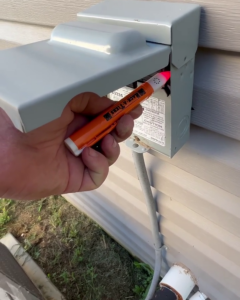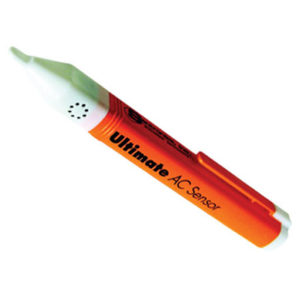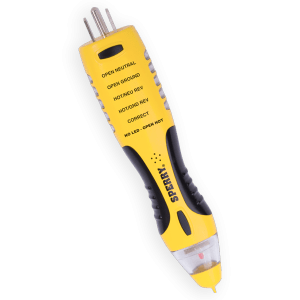What is a Non Contact Voltage Tester & How Does it Work?
 The non contact voltage tester is by far one of the easiest things to use. I know on my jobs these testers have been somewhat ridiculed. For years, I’ve had to sneak using one. The powers that be seem to find them unsafe or ineffective. This is not true in all circumstances. With a working knowledge of the tester and a quality product, you can’t go wrong with having one in your pocket.
The non contact voltage tester is by far one of the easiest things to use. I know on my jobs these testers have been somewhat ridiculed. For years, I’ve had to sneak using one. The powers that be seem to find them unsafe or ineffective. This is not true in all circumstances. With a working knowledge of the tester and a quality product, you can’t go wrong with having one in your pocket.
How do non-contact voltage testers work?
 Non-contact voltage testers test for the presence or absence of voltage. Unlike multi-meters, non contact voltage testers do not need to make contact with metal. Non-contact voltage testers usually feature both a visual light and an audible signal. A non-continuous light, no light, or even a green light with no beeping means voltage is not present. A red light with a continuous tone means there is voltage present. Most models that you find will have a detection range from 50-1000V. However, I have had voltage tester pens ring on 24V control wire.
Non-contact voltage testers test for the presence or absence of voltage. Unlike multi-meters, non contact voltage testers do not need to make contact with metal. Non-contact voltage testers usually feature both a visual light and an audible signal. A non-continuous light, no light, or even a green light with no beeping means voltage is not present. A red light with a continuous tone means there is voltage present. Most models that you find will have a detection range from 50-1000V. However, I have had voltage tester pens ring on 24V control wire.
Non-contact voltage testers operate on the principle of capacitive coupling. No, this did not just turn into a blog on relationships. Capacitive coupling is something all electricians know about. Being king of the trades, and secretly smarter than engineers, gifts us with such knowledge. However, a quick refresher doesn’t hurt anyone.
Recalling how capacitors work, you have two conductors separated by an insulator. Voltage is drawn from one conductor through the insulating material as the electric potential increases. Non contact voltage testers use two capacitors to test for the presence of voltage. One capacitor is the object of testing (conductor), air in the tester end (insulator), and the test sensor (conductor). The second capacitor is you, any insulation between the ground and you, and the ground itself. This simple setup draws voltage across the capacitors (if present) and gives you the red light for danger. Now that we’ve refreshed the engineers, we can move on.
Why use a non-contact voltage tester
Voltage tester pens are the easiest way to check for the presence or absence of voltage. No light or green light, go. Red light, no. It doesn’t break down any easier than that. Knowing it can’t be any easier than this, make sure you always test your voltage tester. Any voltage tester. Always do a live-dead-live test to make sure that your tester is working as it should. Test on a known live source and then a dead source and repeat until you are content with the function. Make sure you have fresh batteries available if you need them and step away from the voltage source if your tester is acting funky.
Non-contact voltage testers often get a bad rap. Some companies even ban them from jobs because of a misconceived notion of their use. Using any voltage tester comes with some risk but it is not nearly as bad as some claim. If you follow the proper safety protocols when working on live circuits, you should have no reason not to trust your non-contact voltage tester. That is unless you have a poorly made product. Fortunately, that’s not the case when choosing Rack-a-tiers.
The best non-contact voltage testers
 Rack-a-tiers offers several options for your testing needs. The classic is the Ultimate AC Sensor. It’s simple, sleek, and made in the U.S.A. It has a standard range of 50-1000V. The Ultimate AC Sensor offers a continuous red light and audible tone to let you know when voltage is present.
Rack-a-tiers offers several options for your testing needs. The classic is the Ultimate AC Sensor. It’s simple, sleek, and made in the U.S.A. It has a standard range of 50-1000V. The Ultimate AC Sensor offers a continuous red light and audible tone to let you know when voltage is present.
 Another product that interests me is the Sperry Dual Check 2-in-1 Tester. This tester offers a voltage test pen and a receptacle tester in one. I know that I have about three receptacle testers floating around and only one of them does GFCI’s. With the Sperry, you get an easy-to-use tester to check for voltage and test all your receptacles. There are no charts on the tester that make you interpret multiple light patterns. All your normal tests have their own respective light. Open ground? The Sperry lights up on the line that says open ground. Open neutral? Same deal. There’re also lights for Hot/Neutral Reverse, Hot/Ground Reverse, and Correct. Each has its own individual light. It’s really a no-brainer and I’m not sure why other testers aren’t this way by default.
Another product that interests me is the Sperry Dual Check 2-in-1 Tester. This tester offers a voltage test pen and a receptacle tester in one. I know that I have about three receptacle testers floating around and only one of them does GFCI’s. With the Sperry, you get an easy-to-use tester to check for voltage and test all your receptacles. There are no charts on the tester that make you interpret multiple light patterns. All your normal tests have their own respective light. Open ground? The Sperry lights up on the line that says open ground. Open neutral? Same deal. There’re also lights for Hot/Neutral Reverse, Hot/Ground Reverse, and Correct. Each has its own individual light. It’s really a no-brainer and I’m not sure why other testers aren’t this way by default.
See all our Non Contact Voltage Testers
Conclusion
I’m sure we’ve all been given a non-contact voltage tester or have bought one only to throw it in the bottom of the tool bag. Take it out and dust it off. If you have the right model, then you should have no fear of using it. I forgot one important note: We talked about potential between conductors contributing to the function of capacitors. With that in mind, your voltage pen will not work properly if your potential to ground is low or nonexistent. I’ve been bitten a few times by not understanding this principle. The ground is a key factor in the function of the non-contact voltage tester. If you are isolated on a ladder with no contact to ground, then you are not giving the tester a proper chance. That’s on you. Keep that in mind the next time you try beating your tester on the pipe to get it to work. Make sure you buy a quality product like those listed above and always make sure you’re using the tester the way it was intended.
Check out our Collection of Electrical Testing & Power Monitoring Tools